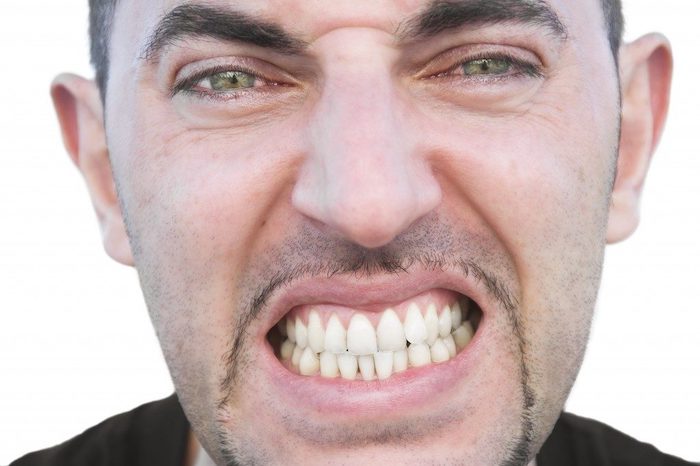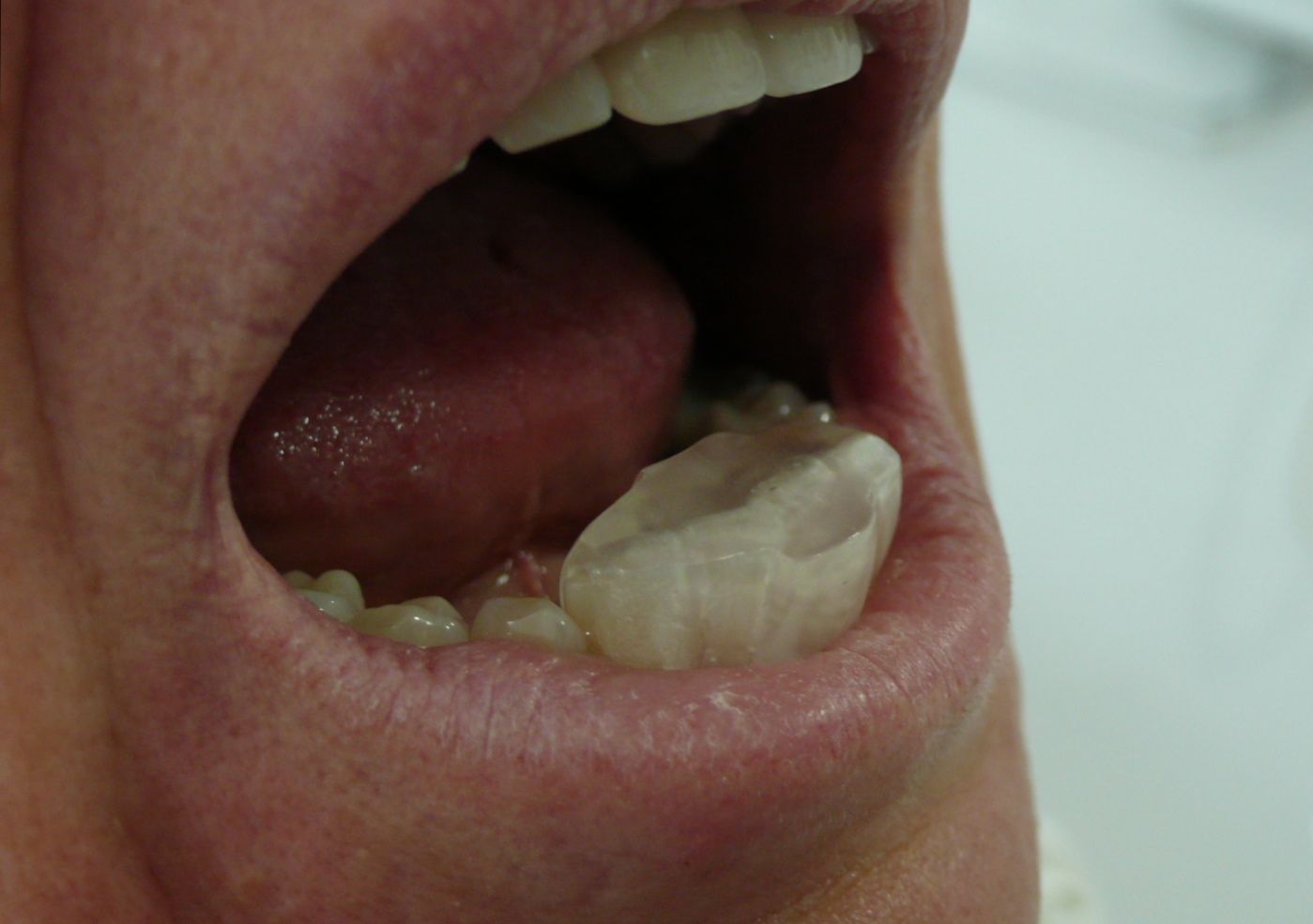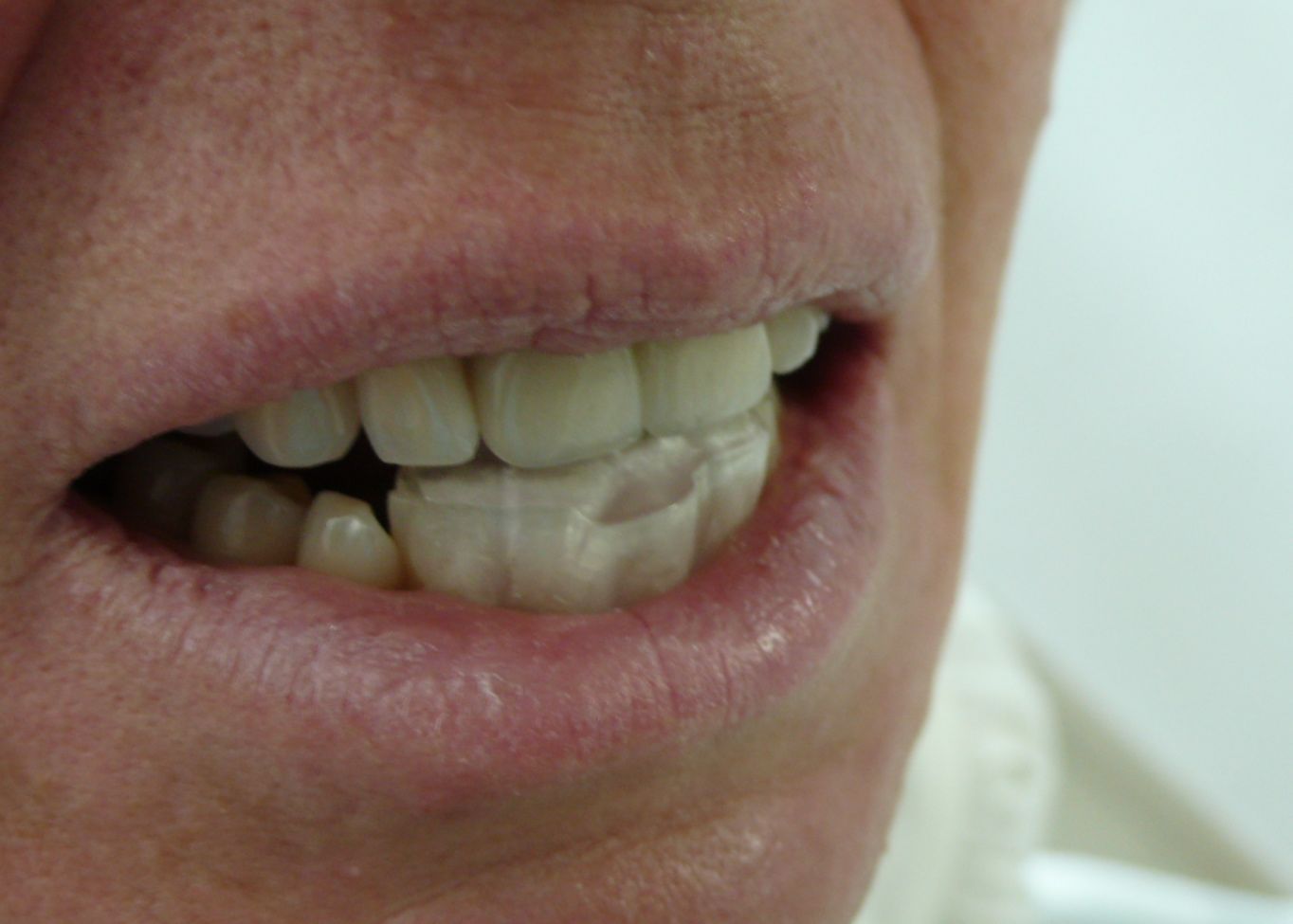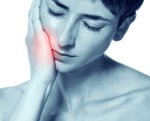How To Fix
Teeth Grinding
Are you wondering how to fix teeth grinding? Your options for teeth grinding treatment are limited to 3 possibilities. Which one is best for you depends on your symptoms, the pain or discomfort you are experiencing, and your personal willingness to persevere with low-level discomfort.
 Grinding teeth!
Grinding teeth!Let's take a look at the different symptoms and signs you might have noticed. (Or your dentist might have noticed).
First Level, you may have noticed absolutely nothing at all. No pain, no discomfort, NADA.
BUT every time you go for a check-up, your dentist murmurs that you are grinding your teeth. They don't say much, whether it's good or bad, or whether you need to get any teeth grinding treatment. They just kind of mumble "gee, you grind your teeth a lot!"
What are you supposed to think about that?
If you hear your dentist mumbling about you grinding your teeth, you should ask him (or her) if you can get a teeth grinding guard. This will be a thin acrylic splint that fits over either your upper teeth or lower teeth, for you to wear at night.
How To Fix
Teeth Grinding
WHY AT NIGHT? Because you grind your teeth the most when you are asleep. Most patients I tell about this become defensive, and argue with me. They say that they definitely do not grind their teeth at night, because they fall asleep with their mouths open and wake up with their mouths open.
BUT what happens between those times, when they are deeply asleep? I can tell you, because I see what happens to the teeth. They are grinding their teeth while they are deeply asleep.
At its mildest form, it will not cause any problems other than the teeth wearing down over time. This will eventually lead to cracks and fractures in teeth and fillings. If you can get a teeth grinding guard made by your dentist, then you will be grinding down the acrylic, and protecting your teeth!
How To Fix
Teeth Grinding
Second Level, you may notice some discomfort or pain around a particular tooth. It may be a tooth you have had some dental treatment on recently, or it may be a tooth that has never had any treatment at all, ever. It will most likely be a back tooth, and you may be getting some headaches too.
This will be due to "an interference" between your upper and lower teeth somewhere. This sort of thing happens gradually over time as your teeth wear down slowly and naturally over years. At some point, a certain tooth will start to "catch" on the opposing tooth.
This will have 2 effects.- the tooth affected will start to become tender to pressure. It may also become sensitive to warm and cold food and drinks.
- you will also get some pain and tenderness in the jaw or jaw joint near the affected tooth.
You may think there's a problem with the tooth. BUT, if your dentist is clever, he or she will check how your teeth meet with some thin blue marking paper. The important thing is not to check how your teeth meet when you bite normally, "in the middle"; you should slide your lower jaw off to the left and right, keeping your back teeth in contact all the time.
AND THAT"S THE TRICKY BIT.
You will tend to avoid the problem tooth. You will slide your jaw around so that the problem tooth doesn't make contact, because it's sensitive.
SO, you will have to force yourself to keep ALL your back teeth in contact, and slowly slide your lower jaw off to the left and right, trying to FIND the offending cusp and make it hit on the blue marking paper.
Then your dentist can see the offending "interference", and the teeth grinding treatment here is to grind down the cusp that is catching. This is painless, because it will be tooth enamel that is catching, and tooth enamel has no sensation.
How To Fix
Teeth Grinding
Third Level, you may be getting headaches and migraines, and have some sinusitis symptoms. This is a more severe form of teeth grinding. Treatment is directed at the cause - intense and prolonged clenching and grinding while you are deeply asleep.
What other signs might you notice, to give you a hint that you may be grinding your teeth? You will have to look carefully, but the signs will be there if you take your time.
- You may notice that you have some sharp edges on some of your teeth. This is because they have become worn down on the biting surface, leaving a sharp enamel edge. This may be on the inner side of the tooth, so that you tend to catch your tongue when you bite; OR it may be on the outer edge, where you bite your cheek from time to time.
- If you look carefully at your tongue, look at the sides, where your tongue would rest against your lower teeth when you mouth is closed and relaxed.You may see a scalloped edge along the side of your tongue. This is actually an imprint of the teeth, where your tongue has pressed during grinding.
- You may wake up in the mornings with a dull headache around your temples, or in your cheeks, just below your eyes. This is caused by the tension of the muscles in your face contracting while you are grinding or clenching your teeth at night time, when you are deeply asleep.
- One other thing you may notice is what we call "restless legs" while you are trying to fall asleep. You want to drift off, but somehow you can't find a position for your legs that feels comfortable. You keep shifting them, as they seem to ache, to get a better position.
- But they keep feeling "odd", and you keep changing leg position. Restless legs. This is now classified as a "movement disorder of sleep", which seems to occur frequently alongside night-time teeth grinding. Treatment is directed at reducing your teeth grinding.
- Finally, you may notice that the gum line around some teeth has moved back, and you can see the root surface (which is less white than the tooth enamel) showing. This is gum recession. There are other reasons for this happening, but if you notice the previous signs of teeth grinding, and ALSO tooth roots becoming exposed, then the chances are that you are grinding your teeth.
A simple splint that covers all your lower or upper teeth with a thin shell of acrylic will not help here. All the "full coverage" splint does is give even more surface area for you to clench and grind on. The muscles around your jaws get an even bigger work-out at night, making your headaches and migraines even worse.
How To Fix
Teeth Grinding
What you need here is a teeth grinding guard that will actually REDUCE your teeth clenching and grinding, not just cover the teeth.
How could this work?
 NTI splint in position
NTI splint in positionThe definitive teeth grinding guard for people with migraines is the NTI splint, developed by dentist Dr. Jim Boyd of Solana Beach, California. This is very different to the "full cover" splint that most dentists are familiar with. The NTI splint is a small acrylic splint that only covers the lower 4 front teeth (incisors).
The idea is that the upper front teeth only meet on the acrylic of the lower splint, and when they do, there is a 1mm gap between ALL the back teeth, in ALL movements, left to right and back to front. The back teeth just cannot meet, in any position.
THIS IS CRITICAL.
If the back teeth can meet in any particular position, you will find this position in your sleep, and grind on that spot all night. OUCH!
 NTI splint in position
NTI splint in positionSo it's very important that your dentist takes the time to make the splint, and check it at several follow-up appointments. The best technique is for the dentist to "paint" the biting surface of the splint with an indelible back marker pen ("Sharpie"). After a week, this will show where you are clenching and grinding, and if the the splint needs any adjustment. It is normal to need 2 to 3 follow-up appointments.
If your dentist just gives you the splint and tells you "that's it!" then you should call back for adjustments after 1 week and 3 weeks.
How to fix teeth grinding? This teeth guard for grinding teeth is the best that I am aware of.



